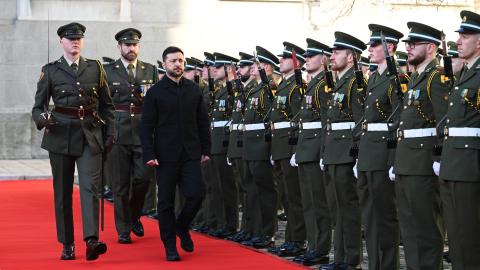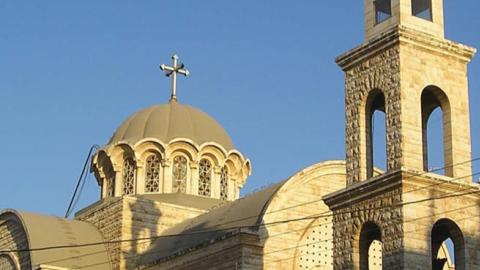On June 10, the U.S. Commission on International Religious Freedom (USCIRF) hosted a crucial hearing in response to numerous reports of religious freedom violations in Northeast Syria.
To American ears, “Northeast Syria” may sound like just another warzone on a foreign map. Yet against all odds, that region has emerged as a unique and impressive success story. Known both as Rojava and AANES—the Autonomous Administration of North and East Syria—it has successfully fielded a representative government offering women’s rights, religious freedom, and social equality.
Since 2012, AANES has performed a remarkable experiment in ethnic and religious diversity in an ancient setting. Kurds, Arabs, Yazidis, and several Christian groups, both historic and modern, have lived there in surprising harmony. And despite ISIS’s 2014 invasion, thanks to U.S. and Kurdish cooperation, the region has survived and even thrived.
But, as noted in USCIRF’s hearing, AANES’s success story is at risk today. Commissioner Nadine Maenza described what followed ISIS’s defeat.
First, in February 2018—while the SDF (Syrian Defense Force) was working with the U.S. coalition fighting ISIS—Turkey and its Islamist allies, many who are known former members of ISIS and Al-Qaeda who are now in the Free Syrian Army, invaded and seized control of Afrin, a religious and ethnically diverse area in north-central Syria that was at the time under the control of the AANES.
This occupation established a deeply disturbing precedent for what was to come: not only were Kurds, Christians, and Yazidis chased from their homes, and sacred sites desecrated and destroyed, but Turkey and the FSA escorted into those abandoned homes hundreds of mostly Sunni Muslim families who had fled regime-controlled areas.
Then, in late 2018, President Donald Trump ordered all but a handful of American troops to withdraw from Syria. And on October 13, in an infamous phone conversation with U.S. President Trump, Turkish President Recep Tayyip Erdogan announced that he was about to launch a military operation in northern Syria. He alerted Trump that the U.S. should immediately withdraw its forces from the area, presumably to avoid an ugly confrontation.
Trump complied with Erdogan’s intentions. And Turkey surged into Syria.
Genocide Watch described the results:
In areas under Turkey’s control, civilians have been subjected to horrific crimes against humanity committed by Turkish forces and Turkish supported militias. Kurdish towns have been bombed and destroyed, some with white phosphorus, a war crime. Hundreds of civilians have been summarily executed. Kurdish and Yazidi women have been kidnapped and subjected to sexual slavery. Secret prisons hold hundreds of Kurds who are routinely tortured.
It is widely believed that Trump’s removal of American troops was ill-conceived. It was deeply disturbing to many U.S. military personnel who had battled alongside valiant Syrian Defense Forces (SDF) fighters, who had sacrificed some 10,000 lives during joint military efforts combatting ISIS.
Turkey’s declared intention was to relocate 2-3 million Syrian refugees across a swath of AANES territory, expelling thousands of residents from their ancestral homes. Erdogan falsely claimed they were Kurdish “terrorists.”
In short, the Turkish agenda was to cleanse the region of Kurdish, Yazidi, Christian, and Arab residents. This meant that AANES’s noble religious freedom endeavors, along with many other positive human rights policies, would no longer be possible—certainly not with Erdogan in charge.
Even today, episodes of Turkish shelling ensue, and water and electricity are unpredictably cut off. Meanwhile abuses of Christians and other minorities erupt randomly. And Turkey remains poised for further incursions.
In November 2019, Hudson Institute’s Center for Religious Freedom hosted Elisabeth Kourie, who represents Syriac Christians in the AANES area. We asked Kourie about the Turkish attacks that have continue to devastate her local communities.
Following Trump’s phone call with Erdogan, within three days, Turkish troops began to move south across the Turkey-Syria border. They bombed all along the border. They were attacking anybody who was there; their targets were not military. Civilians were killed and wounded. Syriac Christians were terrified, fleeing small villages into larger towns. One of the first bombs that came from Turkey struck a Syriac Christian house in Qamishli, severely injuring parents and their children….
We faced them a year ago in Afrin. We faced them in the history of the Ottoman Empire. We have had experience with Turkey with a couple of genocides, the largest being 1915. We know that if Turkey is coming, it’s coming with jihadists. And we know that we Christians will be targeted more than anyone else. Today we estimate that 100,000 Syriac Christians are still somewhere in the area. 100,000 already fled in 2015.
Those who have struggled to bring the AANES vision to life include Bassam Ishak, president of the Syriac National Council of Syria. In a recent email he explained,
Syriac and other Christians are still living in the Northeast region of Syria, but those who stayed there are the poorest and face an unknown future… they are vulnerable to an ultimate political settlement that does not recognize their rights as equal citizens. This is especially tragic because their ethnic and religious identities in Syria predate all others.
Indeed, a full-blown Turkish incursion into Northeast Syria seems likely. Erdogan’s expansive ambitions and loathing of Kurds is indisputable. And without U.S. resistance, Erdogan will carry on his ruthless program of ethnic and religious cleansing in northeast Syria.
The Turkish threat is ominous. Unfortunately, it isn’t the only danger.
Recent reports agree that ISIS in on the verge of making a comeback in the region. The so-called “Cockroach Caliphate” seems quietly to have used the chaotic COVID-19 crisis to regroup and regain its strength.
James Warren writes, “These troops had been guarding about 10,000 captured ISIS fighters in various detention centers and prisons.” After many Kurdish guards withdrew, “…hundreds of ISIS fighters, including a number of senior members of the organization, have escaped, and others may well do so in the coming months, with the help of their brothers on the outside...”
Hassan Hassan, a USCIRF hearing panelist, also warned, “When it comes to ISIS, what starts in Syria will not stay there. And this matters to U.S. interests in regional stability, prosperity, and security. So this is just a perfect example of how the U.S. can protect its interests and be a force of good in the world.”
Tony Perkins, chair of USCIRF, concluded his remarks on a similar note of caution. “Our purpose today is not to uncritically uphold northeast Syria as an inter-religious utopia,” he said. “Instead, it is to highlight what Syria, the Middle East, and indeed the world stands to lose if we fail to uphold and protect the advancement of religious freedom in this vulnerable area.”
Read in RealClear Religion



















